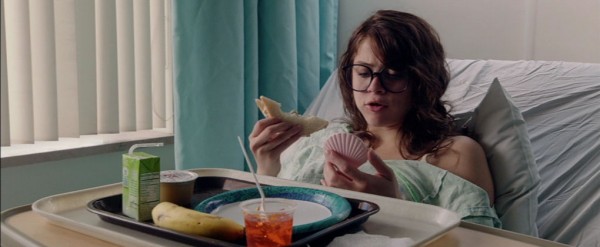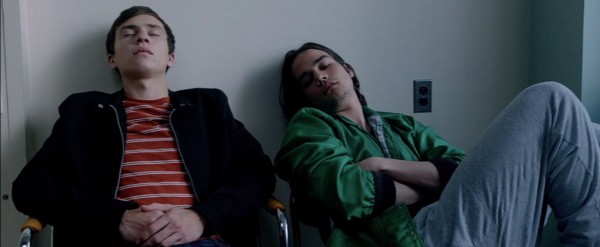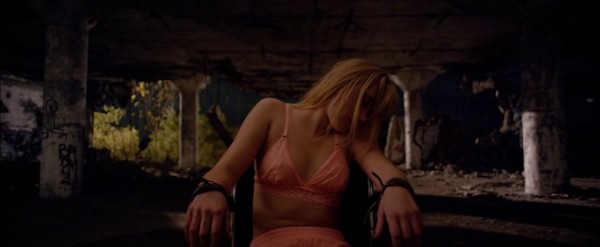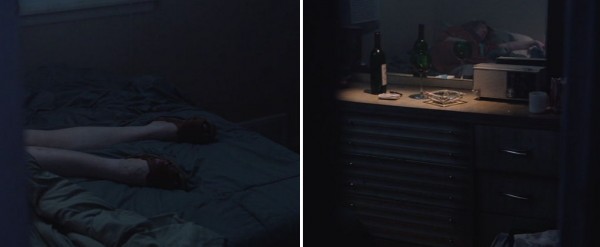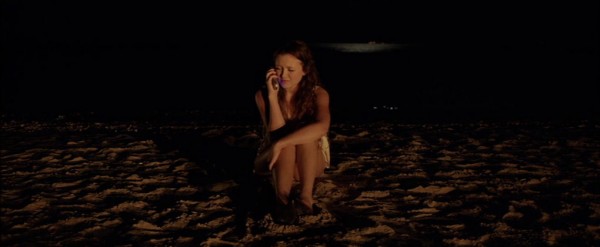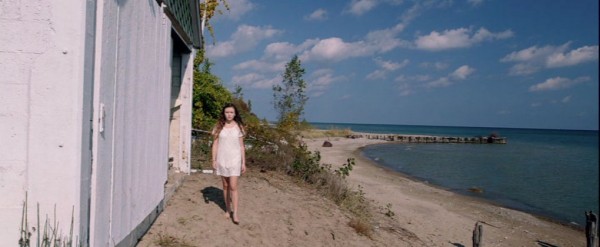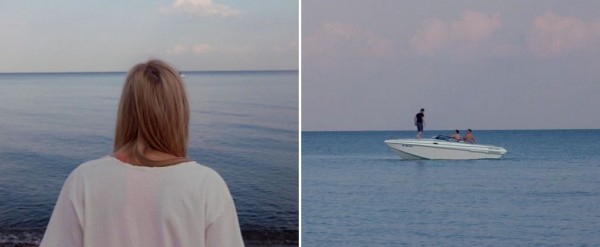
It Follows, part 2: Nightmare in red
The freeze frames from It Follows used in this article are taken from a screener made available to Montages by the film’s Norwegian distributor. The article reveals the whole plot.
*
This is the second of three analytical articles about It Follows by David Robert Mitchell. The first article is a general discussion on the film, structured around ten different approaches to this many-faceted work. The third article revolves around the film’s staging and aesthetics.
This second article is about the film’s intelligent and deeply deliberate use of motifs. It leans heavily on freeze frames from the film and takes for granted that the reader is already familiar with the plot.
Everything is staged
The method is actually quite simple: objects, actions, colours, words in the dialogue, and so on, that occur “more than usual” – especially in situations without acute storytelling function – are per definition of interest. It is of no use wondering whether such overrepresented elements might mean something: films do not make themselves. Everything in the frame may be the result of manipulation, and existing large formations, like buildings and landscape, can be counted on having been shot in a way that best serves the work.
It is therefore reason to believe that overrepresented elements have special meaning in the film and are planted on purpose. Perhaps merely to create a sense of unity, but as a matter of interpretation it is more satisfying to uncover a specific meaning. It is not really required, but often a motif will be present in one or more situations where it is the object of special emphasis – so-called «enabling», an encouragement to look for the motif also in less emphasised occurrences.
The article shall now comment on the penultimate scene of It Follows – its delicate wistfulness makes it one of the film’s best – and touch upon a range of its aspects. This walk-through will also function as a useful introduction to the motifs, since all the important ingredients are in place. In the scene Yara (Olivia Luccardi) reads aloud an utterly depressing Dostoyevsky quote. It is about a man waiting for the guillotine, but can easily be interpreted as a metaphor of the unavoidable death awaiting us all. At this point the curse has been transferred to Paul (Keir Gilchrist) through his intercourse with Jay (Maika Monroe), the film’s protagonist. The Follower seemed to have been annihilated during the climax in the swimming hall, but no one can be sure that it was final. The scenes following the climax bear this out, since the film’s atmosphere is as bleak as ever, maybe even more so.
During an establishing shot where the camera is sneaking up on Yara, Jay and Paul, plus a close shot of Yara, she reads: When there is torture, there is pain and wounds, physical agony, and all this distracts the mind from mental suffering, so that one is tormented by the wounds until the moment of death. And the most terrible agony may not be in the wounds themselves…
[cut to Jay] …but in knowing for certain that within an hour, and then within ten minutes…
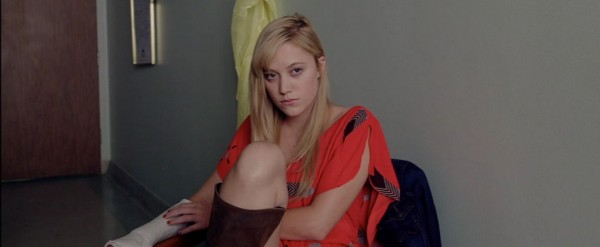
[cut to Paul, while the camera is, almost imperceptibly, closing in on him] …then within half a minute, now, in this very instant – your soul will leave your body…

[cut to Jay, while the camera is now also closing in on her] …and you’ll no longer be a person, and that this is certain.
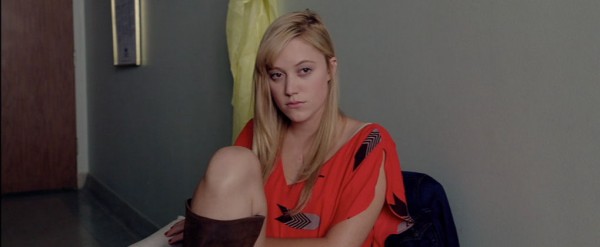
[cut to Yara] The worst thing is that it is certain. As some sort of full stop for the literary seance, Yara now takes a big bite of the sandwich, but even more important – in our hunt for motifs – is the action that ends the scene:
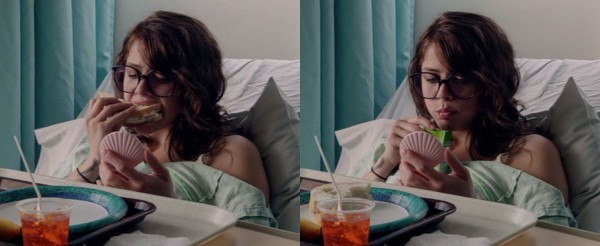
The recitation has accompanied single shots of everyone in the room, underscoring their common fate in the struggle against the Follower. But while the camera has observed Yara in a stationary way, the camera movements binding Paul and Jay together emphasise their special relationship: they have slept together and are among those who are/have been afflicted with the curse. Nevertheless we have the feeling that Jay alone perceives the certainty of the role of death in human life. Paul is asleep and Yara is reading in a monotonous and matter-of-fact voice, as if she does not grasp the full implications of the quote. Mechanically, she then takes in nourishment without at the same time taking in the irony of maintaining life in this unthinking manner, in the light of what she has just read.
It is also of interest to dwell upon the timing of certain keywords. Yara takes her very first bite of the sandwich after having said «moment of death». «Certain» occurs three times: (1) after having sat with downcast eyes, Jay looks up right after this word and then remains attentive; (2) there is a cut back to Yara right after the word, marking the end of our gaze at Jay in the scene; and (3) the word is concluding the entire quote.
It Follows operates with motifs like water and sleep – central elements in the maintenance of life, and red also fits this “importance” pattern as the most striking of the primary colours – in meaningful interplay in a film permeated by basic concerns of life, like sex, death, fear and family. The motifs create patterns that supplement, enrich or interconnect the work. Since cinema provides unique opportunities to sneak in symbolism, under the radar, through objects naturally present in images whose (seemingly) primary function is to tell a story, the use of motifs seldom becomes too overt in the hands of a careful director.
Sleep
Do the frequent occurrences of sleep in It Follows mean something more than contributing to the somewhat drowsy, sleepwalkerlike mood of the film? In the first article (item 6 and 7) we talk about rites of passage between childhood and adulthood, innocence and decay, the adult generation as threat. The teen years are a stage between childhood and adult life, like sleep is a position between life (the state of being awake where we have control of our faculties) and a kind of death (sleep, where we are at the mercy of the subconscious and dreams, living their lives independent of social conditioning and culture). One also speaks of «the sleep of the innocent». In Macbeth the protagonist kills a sleeping person, leading to him being unable to feel safe in his own sleep, and suffering from life-destructive insomnia.
The paradox of It Follows is that sleep is always shown as a safe zone, while it is reality that is the threat, like a nightmare in daylight. While asleep one is a helpless victim of dreams, while awake the characters of It Follows are helpless victims of the Follower. (Another aspect of all the sleeping is that in real life, people suffering from anxiety and/or depression often take refuge in sleep because reality is so exhausting to face.)
It is definitely something dreamlike over the entire It Follows, and at times we have the feeling that the Follower is just a figment of the mind of the victims, especially since it can only be seen by the ones afflicted with the curse, as if a hallucination. Another film with a somewhat unreal, dreamlike mood is Signs (M. Night Shyamalan, 2002), which also has an overrepresentation of sleep. (Described in part 3 of my analysis of that film.) At every point, however, Signs emphasises the very awakening from sleep, often marked by a sudden jolt, connecting sleep to a mood of tortured existence, very different from the serenity of sleep in It Follows.
In this context, it is interesting that Mitchell was inspired to do the film by a childhood recurring dream where Follower-like entities were haunting him. Even though it is difficult to envision two films more different in form and approach, he has also mentioned A Nightmare on Elm Street (Wes Craven, 1984) as a highly important source of inspiration. There the teenagers are fighting against falling asleep, because Freddy Krueger is terrorising them in their dreams (were they to be killed there, they would never awaken again). So the situation in It Follows is turned completely on its head compared to A Nightmare on Elm Street. (There are also other references: a non-understanding, uninvolved parent generation leads to the teenagers having to deal with the Follower/Freddy on their own, and the alcoholised mother in It Follows is a more subtle echo of the heroine’s mother in the earlier film.)
Here is a slide show of the sleepers in It Follows (plus two related situations: Jay awakening from the sedation administered by her boyfriend, and awakening from unconsciousness after the car crash):
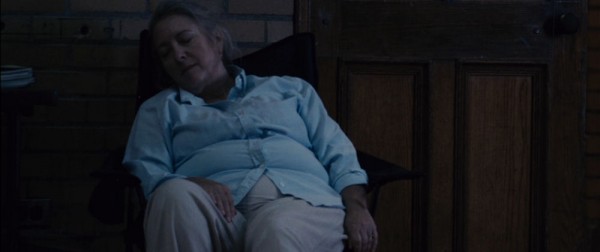
Water
One of the film’s few explicitly gruesome images shows the girl of the prologue, mangled against the background of a sea (with an echo in miniature in the form of a small pool of liquid under her body). Her death is provided with a bittersweet lyrical undercurrent – is the the body of water supposed to create a perspective of eternity? That the sea is important is suggested in the night scene while the girl awaits the Follower, where a lighting effect draws attention to the existence of a body of water in the background:
Below follows a small slide show displaying other situations where larger bodies of water are important: Jay and her boyfriend have a date at a shore. The sea is visually prominent in the scenes at the cabin owned by Greg (Daniel Zovatto), Jay’s neighbour and classmate. One of the Follower bodies turning up there is filmed with the sea conspicuous in all her three shots, giving it an even more unsettling air since “she” resembles the girl of the prologue. Finally, Jay swims out to three boys in a boat to engage them in sex.
The importance of water in It Follows reaches its zenith in the film’s climax, which takes place in a swimming hall (see the third article). Water also seems to have decisive importance for the characters’ success in overcoming the Follower, since it seems unable to withstand being shot while immersed in the pool. (Also in this, It Follows has something in common with Signs, since water was the aliens’ weakness, and Signs too used occurrences of glasses of water as a premonition of this fact.)
The swimming pool in Jay’s backyard is a story of its own, in addition to being a harbinger of the swimming hall. In the first article (item 7) we saw that it played a part in a general depiction of decay in It Follows, but it has even more functions. The pool occurs in four scenes, appearing to suggest an increasing degradation of Jay’s innocence:
- In Jay’s introduction scene, symbolising safety and a trusting attitude to the world. She shows the same innocence after the first intercourse with her boyfriend, which is depicted as an unconditional pleasure. But suddenly she is exposed to a world that is cruel – sex is now not only shameful but linked to mortal danger, represented by the Follower who can be seen as a symbol of an adult world insisting that sex is not an innocent activity, emphasised by the Follower’s obscene nudity. Bound to the wheelchair, Jays is forced to become part of this perverted worldview. Later, the adult world will in fact force her into prostitution.
- In a brief glimpse among the moody exterior shots leading up to the scene where Jay’s friends sleep over at her place to protect her against the Follower. She will soon meet the Follower in the kitchen in the form of an abused, half-naked woman, possibly a prostitute – again a perverted image of sex.
- After having slept with Greg at the hospital, since he has offered to take over the curse from her. She is unable, however, to free herself from her paranoia, fleeing into the house to isolate herself in her bedroom. Through the intercourse she has in a way prostituted herself to get rid of the curse, an act that becomes even more dubious since it is highly uncertain whether Greg in fact believes in the curse, or is just a womanizer wanting to conquer her. (While she is in the pool, a news report is rolling on TV about a fire – the opposite of water – that threatens to spread out, like the threat of the Follower.)
- After she has had sex with one or more of the boys in the boat, the pool is shown empty of water and soiled with rubbish. Just like after the previous pool scene, she shuts herself inside the bedroom (this time with her female friends). Again the pool appears in the wake of sex, the connection even stronger now, because she swam in the sea to reach the boys. The prostitution is now even worse, more brazen and ruthless, since she has doomed one of the boys to certain death through the curse.
When Jay finally also sleeps with Paul, even then she cannot escape the ambiguity Greg represented. Neither she nor we are convinced about the extent that Paul sincerely wants to help her or just fulfills a sexual conquest he has coveted since childhood. The mood after their intercourse is far from happy, while the rain is hammering down as a reminder of the Follower. We also sense that sex was a reward for Paul having had the plan that led to victory over the Follower. In the last scene, the potential Follower seems to have «sprung from» the couple’s folded hands, as a sign that their companionship is built on compromise, prostitution and necessity, not pure and innocent love. (In this scenario, it is thus eminently suitable that Paul is pondering to pass on the curse to some prostitutes.)
The journey from innocence to perversion is also mirrored in a miniature version of the trajectory. In childhood Jay and Paul found a stack of porno magazines, but when the consternated adults discovered this, both received «sex education» by their parents, in a transition from the child’s innocence to a more grown-up (and shame-infested) world. Then Paul finds a new collection of such magazines in the house where the teenagers are looking for the real identity of Jay’s boyfriend. An almost imperceptible, soft music starts playing on the soundtrack, as if in allusion to sweet memories from childhood. But the past innocence about the magazines is now irrevocably changed into something dirty and coarse, both through their knowledge of the curse and the surroundings of the «degenerated», decaying house.
There are more larger bodies of water in It Follows. All three paintings we see in Jay’s home, in the living room and the corridor towards the kitchen, contain subjects to do with seas and rivers…
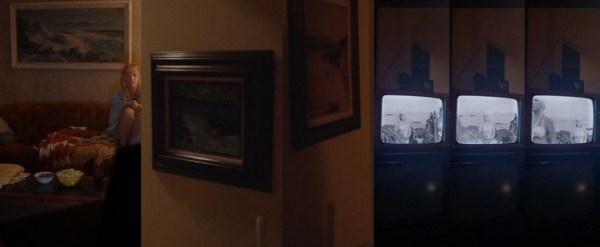


Amusingly, fluids are also a contributing factor in Greg’s demise. He does not really believe in Jay’s story about the Follower; he was busy urinating when the Follower attacked on the beach, so he missed the event that convinced everyone else about the existence of the Follower.
Fluids for drinking
The big water surfaces and swimming pools in It Follows are propagated on a smaller level, in water and fluids drunk by the characters. One of the most beautiful examples is served in the above image, where water-drinking is fetishised through an odd composition (and an unusual way of drinking). It is difficult to say, of course, how much of this shot’s purpose is to create a general feeling of strangeness – in which the film is drenched – and how much it is supposed to emphasise water as symbol and motif. But since we can never fully know the filmmaker’s intention – besides the possible result of unconscious processes in the director – we have no other choice than productively dealing with what actually exists in the film.
The below scene is central, because it introduces Jay in the film. In all eight frontal shots of her, there is always a can of soft drink near her head. (The can also ties into the red motif.)

Soft drinks and beer are often imbibed in the film, almost like a ritual. Below is a montage of a number of scenes where an assortment of cans (and a pocket flask) are in action:
Far left in the lower row, Kelly grimaces after a taste from Paul’s can, which he has spiced up with liquor from a pocket flask (from which we later see him drink directly). Paul has to endure a lot of ribbing from Kelly and Yara, and he does not seem particularly popular with them. Nevertheless he is tolerated as part of the “gang” – may the reason be that he, being a bit older than at least Kelly, is able to provide them with alcohol?
One can suspect, of course, that all these cans are simply product placement. Even so, it is seamlessly integrated in both the characters’ universe and the film’s larger water motif. But «Coolidge Cola», which is quenching their thirst in the largest image does not appear to exist in reality, so the product theory is dubious. An example of subtle emphasis on drinking comes in the first scene from Greg’s viewpoint: it is striking how it starts with lingering on him fishing a can of beer out of the fridge (far right, lower row above), and then follows him transporting it into the living room.
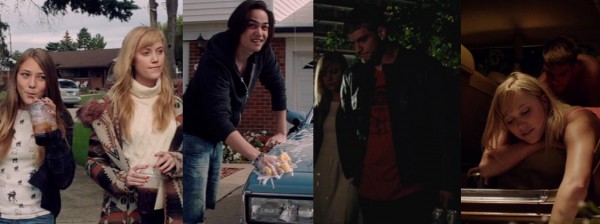
The cinema scene is an inferno of drinking and water references. Jay and her boyfriend play a game: which one of the cinemagoers would they wish to change places with in life? He surprises Jay by having chosen a child instead of her candidate, a man standing with a beautiful woman and…
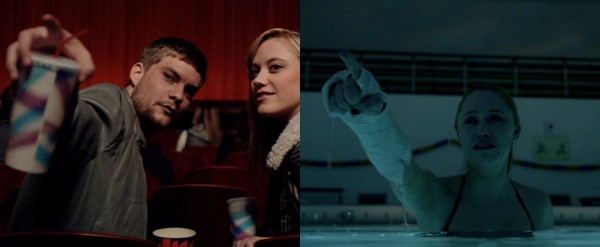
Drinking is even further connected to the Follower: at two occasions crushed cans have been hung up in windows, as an alarm signal if a Follower should enter. Jay’s hysterical, rather odd exclamation «I need water!» when she is afraid that a Follower at any time could enter the bedroom, also fits the pattern, as well as glasses of orange juice being a vital part of the two stylised shots of plates of food (here). Very soon after the first occurrence, the camera is mysteriously gliding along the kitchen worktop before it ends up gazing at the mothers of Jay and Greg, drinking wine together. One motivation behind this movement is probably to have the faucet appear in the shot. Finally, Jay’s mother is almost always depicted with wine glasses and bottles nearby.
Red
The below montage is six shots from the «I need water!»-scene, where Jay has taken refuge in her bedroom after having met the Follower as the woman in the kitchen. On the wall a red cloth (a towel or some clothing) is hanging – incidentally, the same colour as the Follower’s skirt – and the situation is staged so that Jay repeatedly returns to a position close to the cloth.


As the most striking of the primary colours, red is also the most useful one in matters of coloured coding. With a colour-seeking gaze one does not have to see much of Halloween (1978) or The Sixth Sense (1999), two works referred to in the first article (item 4 and 5), to see that red plays an important role. (This is far from a superficial trick resorted to by “commercial” filmmakers. For example, the Japanese master Yasujiro Ozu was supposed to have been obsessed by red; for example, the colour is present in small daubs as often as he could in Equinox Flowers [1958]).
Cinematographers prefer to avoid strong colours because they might distract from the storytelling, and this is one reason that so many Hollywood films have a virtually monochrome, almost black-and-white-like look. The trick is to apply the colours one wishes to ascribe specific meanings in a delicate and precise fashion, and in the extras on the The Sixth Sense Blu-ray, M. Night Shyamalan tells how he banned all other use of red except in objects intended to conjure up meaning.
An analyst’s search for red objects in It Follows becomes a bit like the characters’ paranoia about the possibility of discovering the Follower in any situation. Red means danger, among other things, something that may sound banal, but there is nothing trite about how the colour is woven into the film.
In the scene where Jay and her boyfriend are at a restaurant, she is surrounded by red (this is even before she knows about the Follower, so red is here functioning as an alarm signal):

Below is the start and end point of the film’s most elaborate and art-film-like scene – the teenagers visit a school to find the real identity of Jay’s boyfriend – a 91-second take where the camera twice swivels around its own axis, before it closes in on a situation framed by a door:

Below is the film’s most wonderful “scare moment” where the entire audience jump in their seats by the sudden sound of a ball banging against the bathroom window (this is far from primitive, cheap manipulation: it is essential that the viewer get to experience exactly the same shock as Jay, whose nerves are utterly on edge at this point of the film):
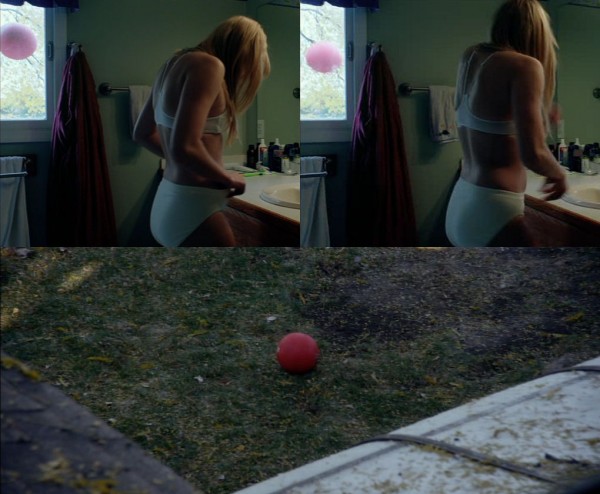
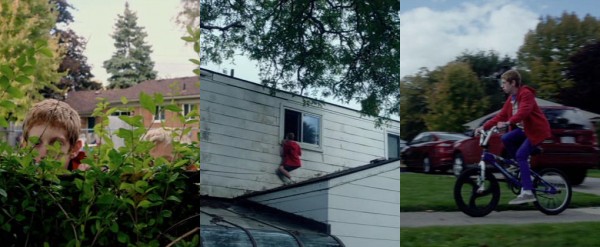
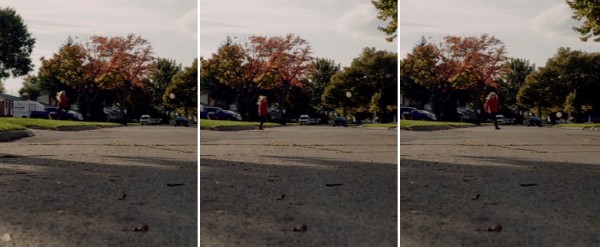
The following scene – the situation where Jay through the classroom window discovers the Follower approaching in an old woman’s body – occurs directly after the ball against the window, as if the ball was an urgent signal to look for more red objects:
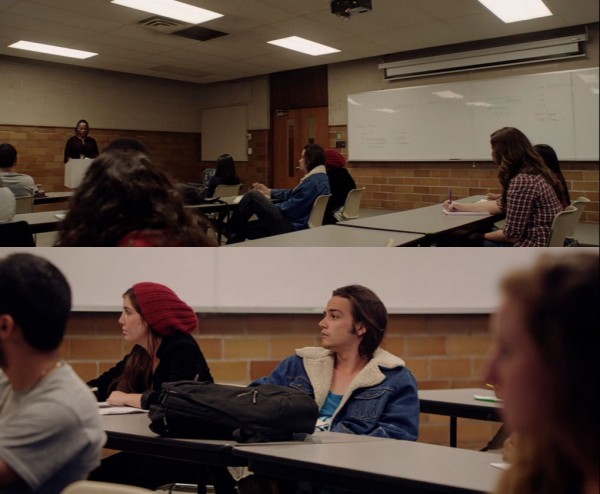


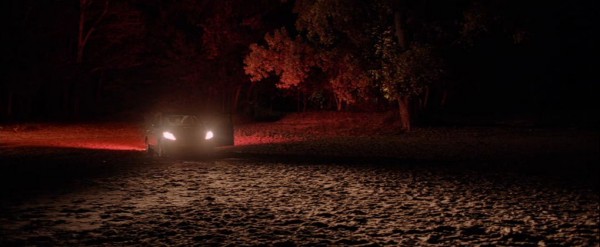


Actually, all six shots of the final scene (see the first article, item 10) contains small elements of red: (1) the man with the rake; (2) the fire hydrant just over Paul’s shoulder; (3) the man again; (4) Jay’s nail in the close-up of the couple’s hands; (5) the potential Follower, and then the man is also added; (6) the car at the edge of the shot.

It is reasonable to connect the left shot above, Jay in a T-shirt with an image of a woman holding a red balloon, to the red ball that smashed against the window – the most obvious expression of Jay’s paranoia about a disaster that at any time can throw itself at her. It is fitting, then, that Jay wears this T-shirt during the film’s most monstrous incident: Greg being sexually murdered by the Follower in his mother’s body. The girl on the T-shirt is blond like Jay, and even though she is laughing, the grimace of her mouth could also be read as a terrified scream.
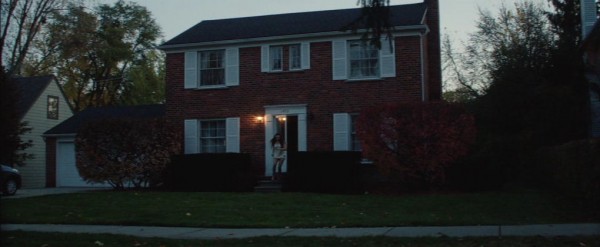
The red motif also provides comments on the perversion of Jay’s sexual innocence, as discussed in connection with the swimming pool. Having sex with her boyfriend in the car, we see Jay in red/pink underwear, which is also strongly emphasised in the iconic scene where, bound to the wheelchair, she meets her first Follower. When she later in the film wakes up on top of the car hood, she then walks through the grove and down to the sea. There she undresses and swims towards a boat with some boys, evidently to pass on the curse to them by having sex.

One of the saddest scenes of It Follows occurs when Paul, pondering passing on the curse, rounds a street corner with two haggard prostitutes under a leaden sky in a post-industrial wasteland. The scene ends with one of the prostitutes shown from behind, and the angle and her red pants seem to form a direct connection to the next scene: here the camera closes in on Jay from behind, and she is dressed in bright red, her most powerful connection to that colour in the film. (Paul is also present, reinforcing the connection.) Another link in the loss of innocence and the prostitution that are besmirching Jay:

Below is one of the most discreet occurrences of red, where the colour usage is of course impossible to detect consciously, at least the first time we see the film, immersed in the drama of the situation. Here Jay runs from the Follower at Greg’s cabin, before she drives off the road, injuring herself:

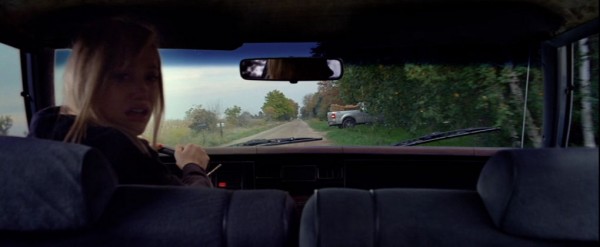
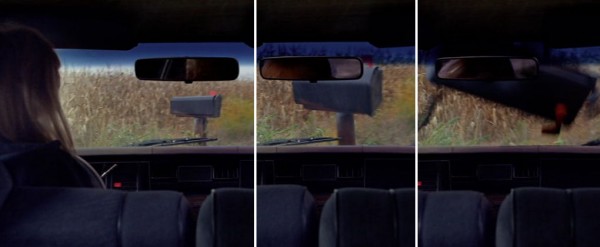
Purple is a colour related to red. The colour scheme during the swimming hall climax is tinged with purple, but this device also occurs earlier:

A car body similarly drenched in purple also occur when they are about to leave for the swimming hall, as if a harbinger of the climax’ purple haze. Here they are observed by the mysterious boy, who also chimes in with the colour scheme, since both his pants and bike are dark purple (even more evident here):
In It Follows one always feels there is an uncanny link between Jay and the boy who appears to be stalking her. In this scene Jay is for the first time dressed in deep-red clothing. This plays a part in a curious coincidence, because the boy is always in red, and the bicycle he now suddenly turns up on, appears to the same Jay used to escape a Follower earlier in the film. It is unclear who actually owns the cycle, but object, action and colours form a peculiar knot of connections:
Red nails
We shall end this article by following one of the film’s most memorable patterns: Jay’s red nails. In the scene where she spots the old lady at school, her nails are discreetly contributing to the mood, by her constant fingering of a pencil. Throughout It Follows, her nails function like a stigma – the infection/curse of the Follower refusing to let go. Jay has red nails right from the start of the film, but it is only when she has been “infected” through sex with her boyfriend that they are given prominence in the mise-en-scène. The following walk-through concentrates on certain heavily stressed stations of the nail pattern, forming a clear line through the film.
For the full benefit of the analysis, we should first look at trees and greenery – other elements strongly connected to Jay, including in this rather emphatic echo:


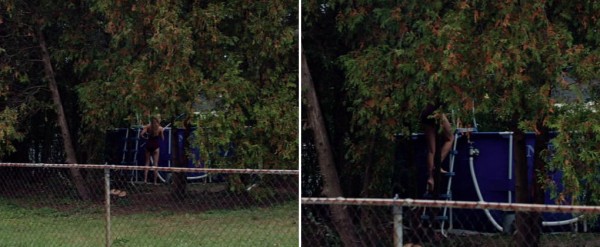
Jay is definitely connected to grass, bushes and trees. In three other situations we see her gaze, almost instinctively – as if searching for her former safety – being drawn up into the trees: while awaiting a possible Follower at the playground, while keeping an eye on the street before Greg is killed, and before falling asleep on the car hood. Red for danger, green for harmony – this leads our thoughts to Mitchell’s source of inspiration, Nightmare on Elm Street, where (according to the IMDb) the original colour scheme for Freddy Krueger’s sweater was red and yellow. This was changed, however, when director Craven learned that it was red and green that formed the strongest contrast for the human retina.
Now we are equipped for a look at one of the most memorable scenes in It Follows, and later the pattern springing from it:


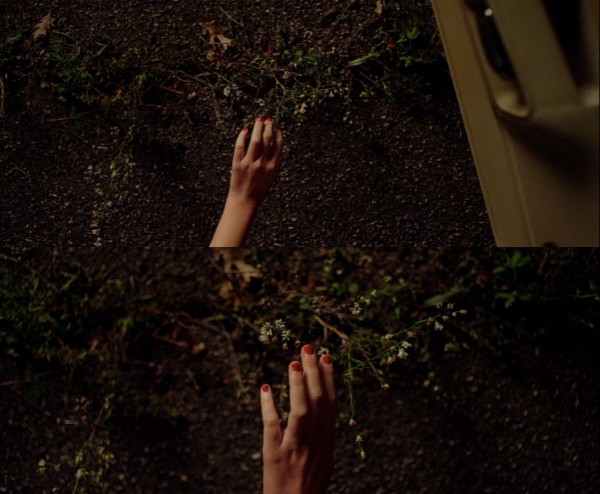

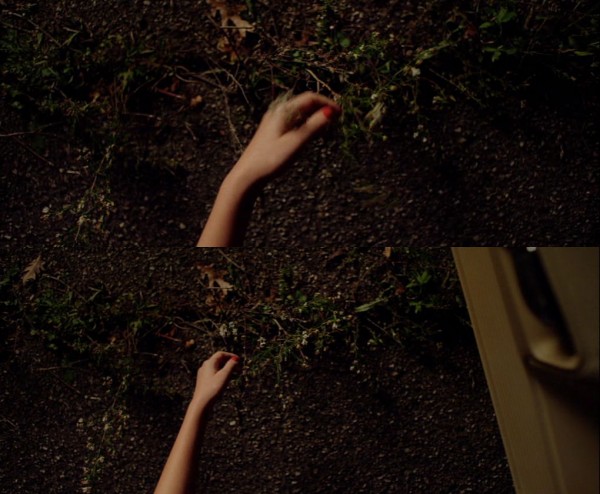

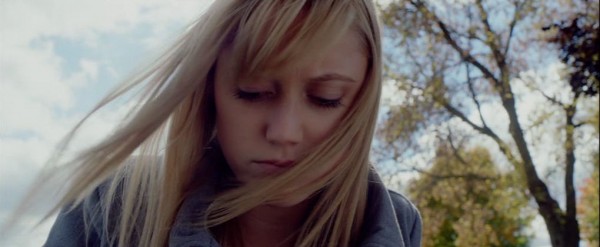

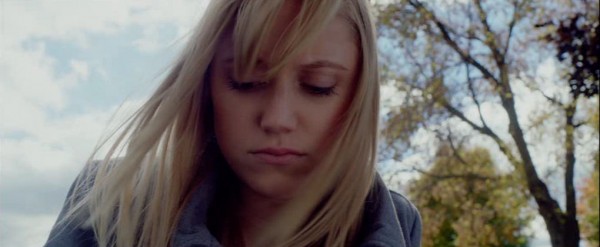

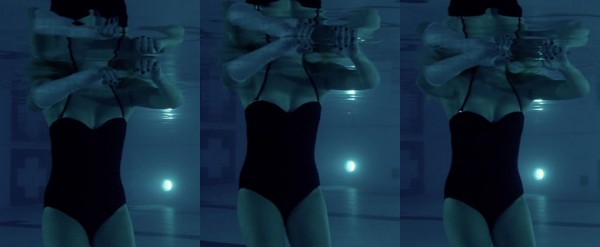
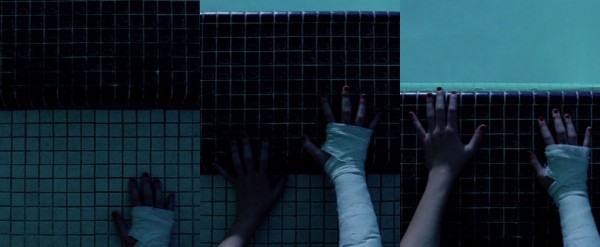
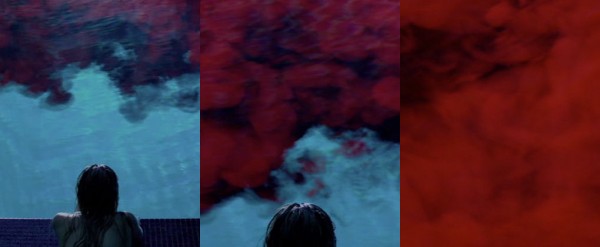
*
Water is transformed into blood, as the film’s two most important motifs converge, while the submotif of the nails has constantly played its supporting role. The motifs tell their own abstract “story”, in parallel to the surface story’s literal narrative.
